By Scott Maxham, former IWLA Clean Water Fellow
You may already know that we advise stream monitors not to collect aquatic macroinvertebrates in the winter. Is it because we know how busy you are during the holidays? Do the bugs head south with the snowbirds? Or do we simply not want you to freeze your toes off?
None of the above. (Although we really do want you to avoid freezing off any body parts!)
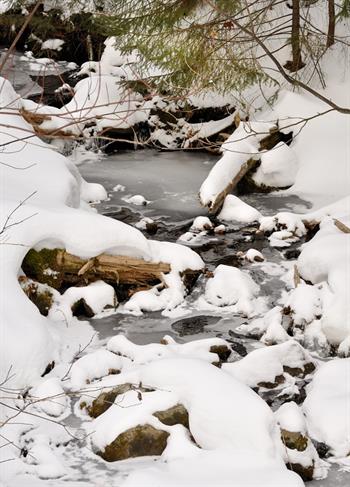 During cold weather, streams are not as “productive” (in terms of aquatic life) as they are during warm months. It’s likely you would not be able to find certain macroinvertebrates due to weather conditions, which would give you an inaccurate reading on stream health. But there is still plenty of life in those streams when they start to freeze over.
During cold weather, streams are not as “productive” (in terms of aquatic life) as they are during warm months. It’s likely you would not be able to find certain macroinvertebrates due to weather conditions, which would give you an inaccurate reading on stream health. But there is still plenty of life in those streams when they start to freeze over.
In fact, most aquatic macroinvertebrates live in streams throughout the winter. Water is an incredible insulator and resists changes in temperature. Although streams can freeze over, the ice is typically only a few inches thick. This layer of ice also provides extra insulation. The bottom of the stream is like the inside of a “river sleeping bag.” The stream bed offers geothermal heat, while the surface of the stream is protected from changes in air temperature by the layer of ice.
Don’t get me wrong, this water is still only a few degrees above freezing. But aquatic macroinvertebrates manage to survive these temperatures using different survival tactics, from overwintering in egg form to staying in the larval stage.
I decided to interview a few of my favorite aquatic macroinvertebrates to find out how they make it through the winter. The bugs need to get back to the creek soon, so we’ll keep it brief!
Steven Stonefly (larva)
Actively hunts in winter under the ice, taking advantage of the all-you-can-eat buffet while other macroinvertebrates are hibernating.
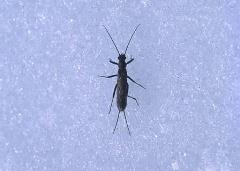 Scott Maxham: How does a frozen bug taste compared with a non-frozen bug?
Scott Maxham: How does a frozen bug taste compared with a non-frozen bug?
Steven Stonefly: I really love the extra crunch you get.
SM: Like freezing a Go-GURT?
SS: Yes, precisely.
SM: Doesn’t it get cold in the stream?
SS: If I stood still, it would. Moving around keeps me warm and allows me to hunt.
SM: Do you like the winter?
SS: It’s much safer. No animals marching on me and my friends. The fish slow down. It’s a magical time of the year. Have you ever watched snow fall on the ice above you?
SM: No, Steven, I can’t say that I have. Glad you are enjoying a vacation from stream monitors. See you in the spring!
Sally Snail
When cold weather strikes, she burrows deep into the mud to keep warm.
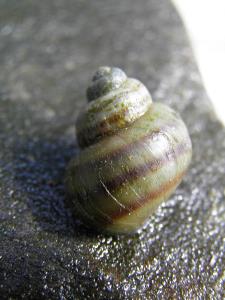 Scott Maxham: Sally, I have been told you have a different tactic for surviving the winter.
Scott Maxham: Sally, I have been told you have a different tactic for surviving the winter.
Sally Snail: I prefer to dig down into the mud over the winter and hibernate.
SM: Like a bear?
SS: What’s a bear?
SM: Oh, erm, I mean, that’s an original idea. Do you like the winter, Sally?
SS: It’s rather boring. You think moving a few inches a day is dull? When you spend three months in one place, it really puts things in perspective.
SM: How do you know when to get up? Do you have some kind of snail alarm? Does the “snail mail” arrive?
SS: Ha, ha. No, Scott, nothing quite that interesting. When the mud begins to thaw, we can feel the change in moisture and temperature.
SM: Fascinating! Well, it’s a long trip back for you. I don’t want to keep you any longer!
Marty Midge
Survives by producing antifreeze.
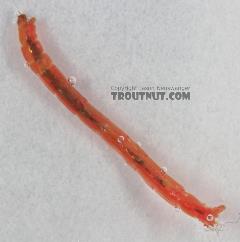 Scott Maxham: Marty, I have been told that you have a peculiar way of surviving winter.
Scott Maxham: Marty, I have been told that you have a peculiar way of surviving winter.
Marty Midge: That’s right. I simply slow down my body functions and produce natural antifreeze to stay alive.
SM: So how does that work?
MM: I convert energy into sugar and remove excess water from my body. It’s nothing, really.
SM: Interesting tactic, Marty. So is this your favorite season?
MM: Heck no! Just because we survive the harsh winter months doesn’t mean we enjoy it. Being a freeze-dried bug isn’t much fun.
SM: Well, grab a cup of hot tea before you go back into the cold water.
Deb Damselfly
Some use their sword-like tail to cut into plants and lay eggs there.
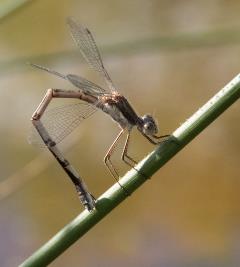 SM: Good afternoon, Deb. So how do you survive the cold?
SM: Good afternoon, Deb. So how do you survive the cold?
Deb Damselfly: Frankly, I don’t. But I lay my eggs in a stream-side plant before I go to keep them safe and warm and let the next generation “diapause” until they are ready to hatch.
SM: Diapause?
DD: Diapause is a just fancy word for pausing growth until conditions are just right. It helps us begin our lifecycle at just the right time.
SM: How long does one diapause?
DD: It’s not a set number of days. It depends on factors such as temperature and length of day.
SM: So you basically avoid winter?
DD: Our eggs are technically alive through the winter. They simply lie dormant in the plants, which stay warmer than air temperatures.
SM: Thank you for your time, Deb.
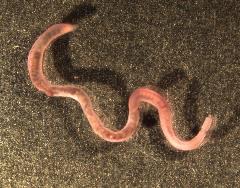
Arnold Aquatic Worm
Encases himself to stay warm.
SM: Well, Arnold, let’s jump right into it. How do you spend your winters?
AAW: Oh, you know, curled up next to the fire with a big mug of hot cocoa?
SM: Really?
AAW: No, but I wish I did! When the temperatures drop, we curl up like a snake and encase ourselves in mucus that hardens up like a chrysalis. We do our best to hide in leaf packs, around aquatic plants, or under rocks. When the weather warms up, we break out and go on with business as usual.
SM: That sounds like a close second to a crackling fire and cocoa….
No matter what they do to stay warm in the winter, your local aquatic macroinvertebrates will be looking forward to seeing you this spring. As you drink your hot cocoa, remember that these miraculous organisms are extremely well-adapted to the streams we find them in!
Can aquatic macroinvertebrates survive the winter in your stream? Find out with our FREE test kit